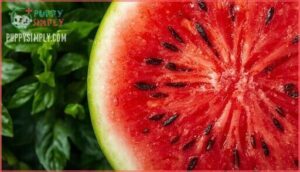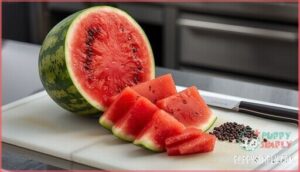This site is supported by our readers. We may earn a commission, at no cost to you, if you purchase through links.

Watermelon is safe for dogs when prepared correctly—seeds and rind removed—and it’s more than just a tasty snack. With 92% water content and a blend of vitamins A, B6, and C, this low-calorie treat offers genuine nutritional benefits while keeping your pup hydrated on hot days.
Understanding how to serve watermelon properly ensures your dog gets all the benefits without the risks that seeds and rind can pose to their digestive system.
Table Of Contents
- Key Takeaways
- Can Dogs Eat Watermelon Safely?
- Nutritional Benefits of Watermelon for Dogs
- Potential Risks of Feeding Dogs Watermelon
- How Much Watermelon Can Dogs Eat?
- Can Puppies Eat Watermelon?
- How to Prepare Watermelon for Dogs
- Signs of Adverse Reactions in Dogs
- Watermelon Alternatives and Dog Treat Options
- Foods to Avoid When Feeding Dogs
- When to Consult Your Veterinarian
- Frequently Asked Questions (FAQs)
- Can puppies eat watermelon?
- Can dogs eat watermelon seeds?
- How much watermelon should a dog eat?
- Is Watermelon good for dogs?
- Can dogs eat watermelon rind?
- Is Watermelon good for You?
- What are some creative recipes using watermelon for dogs?
- Is it okay if my dog eats the watermelon rind?
- Can dogs eat yellow watermelon and red watermelon?
- Should I feed my dog seedless or seeded watermelon?
- Conclusion
Key Takeaways
- Dogs can safely eat watermelon when you remove all seeds and rind, as the seedless flesh provides hydration (92% water) and vitamins A, B6, and C without posing digestive risks.
- Watermelon seeds can cause intestinal blockages, especially in smaller breeds, while the tough rind triggers vomiting, diarrhea, and potential obstructions that may require emergency veterinary care.
- Portion control matters—limit watermelon to no more than 10% of your dog’s daily calories (1-2 cubes for small dogs, up to 10-12 cubes for extra-large breeds) and serve only 2-3 times per week to prevent digestive upset from excess sugar and fiber.
- You can serve watermelon fresh in bite-sized pieces, frozen as hydrating treats, or pureed with plain yogurt, but always consult your veterinarian first if your dog has diabetes, kidney issues, or other health conditions that could be affected by the fruit’s natural sugars and water content.
Can Dogs Eat Watermelon Safely?
Yes, you can safely give your dog watermelon—but only the seedless flesh. According to the American Kennel Club, watermelon is safe for dogs when properly prepared, meaning all seeds and rind are removed. The fruit itself is over 90% water, making it a revitalizing, low-calorie treat that won’t derail your pup’s diet. Whether you choose organic watermelon or regular varieties, both work fine as long as you follow safe preparation practices.
The key is understanding potential hazards for dogs: seeds can cause intestinal blockages, especially in smaller breeds, while the rind’s tough texture creates digestive upset and poses rind concerns. Watermelon allergies in dogs are rare but possible, so watch for reactions when introducing this treat. It also offers hydration benefits, being 92% water.
For food safety, veterinarians recommend keeping watermelon—and all treats—to no more than 10% of your dog’s daily calories.
Nutritional Benefits of Watermelon for Dogs
Watermelon isn’t just a tasty summer snack—it’s packed with nutrients that can benefit your dog’s health in meaningful ways. From essential vitamins to powerful antioxidants, this juicy fruit offers more than just a sweet treat.
Let’s look at the specific nutritional advantages watermelon brings to your dog’s bowl.
Vitamins and Minerals
Watermelon packs a nutritional punch with vitamins A, B6, and C that work together to support your dog’s immune system, skin health, and metabolism. Vitamin A sharpens vision and cellular health, while B6 regulates energy metabolism and neurotransmitter production. Vitamin C acts as a powerful antioxidant, fighting inflammation and boosting immune response—nutrients your dog’s body can readily absorb and use.
Each cup delivers roughly 155 mg of potassium, which keeps muscles and heart functioning properly.
It’s also a hydrating and nutritious snack for dogs.
Hydration and Water Content
With 92–96% water by weight, watermelon acts as a natural hydration booster, especially valuable during hot weather or after exercise. That high water content bolsters kidney function and blood volume while delivering only 46 calories per cup—an ideal energy density for maintaining electrolyte balance without excess weight gain.
The combination of moisture and fiber aids water retention in the gastrointestinal tract, keeping your dog comfortably hydrated throughout the day.
Antioxidants and Amino Acids
Beyond keeping your dog hydrated, watermelon delivers powerful antioxidants that combat oxidative stress and protect cellular health. Lycopene benefits include defending cells against free radicals, while the amino acid L-citrulline improves circulation by boosting nitric oxide production.
Vitamin C scavenges damaging compounds, reducing inflammation and supporting canine health as your dog ages. These nutrients work together to boost nutritional value, offering real health benefits for joints, cognition, and overall vitality.
Potential Risks of Feeding Dogs Watermelon
While watermelon offers plenty of benefits, it’s not without its hazards. A few simple mistakes can turn this healthy snack into a health concern for your dog.
Here’s what you need to watch out for before serving up that juicy treat.
Seeds and Intestinal Blockage
While it might seem harmless, even a few watermelon seeds can create serious problems for your dog. Seeds are indigestible and can accumulate in the gastrointestinal tract, especially in smaller breeds. The American Kennel Club warns that ingestion may lead to intestinal blockages requiring surgical intervention.
Key risks of watermelon seeds include:
- Small dogs face higher breed susceptibility to obstructions from just a few seeds
- Seed ingestion symptoms like vomiting, diarrhea, and abdominal pain often appear within hours
- Blockage diagnosis usually requires veterinary imaging and immediate treatment
- Prevention strategies are simple: always remove all seeds before offering watermelon to your dog
Rind and Digestive Upset
The tough, fibrous rind is a recipe for trouble. Your dog’s digestive system can’t break down this tough outer layer, leading to vomiting, diarrhea, and abdominal bloating. In small breeds, the rind poses a serious choking hazard and potential intestinal blockage requiring emergency care. Veterinary experts strongly recommend complete rind removal before serving.
| Risk Factor | Potential Impact |
|---|---|
| Fiber content | Triggers gastrointestinal upset and bloating |
| Difficult digestion | Causes vomiting and diarrhea within 12-24 hours |
| Physical obstruction | Creates intestinal blockage, especially in small dogs |
| Emergency symptoms | Leads to lethargy, appetite loss, and dehydration |
Always prioritize intestinal health by removing every trace of rind before offering watermelon to your dog.
Overconsumption Concerns
Even the healthiest snack becomes a problem when your dog eats too much. Overconsumption can trigger digestive issues like diarrhea or constipation due to watermelon’s high fiber and water content.
With roughly 9 grams of natural sugars per cup, excessive sugar intake may spike blood glucose levels—particularly risky for diabetic or overweight dogs.
Feeding guidelines recommend limiting treats to 10% of daily calories, emphasizing portion control to prevent gastrointestinal upset and long-term health risks like weight gain.
How Much Watermelon Can Dogs Eat?
Watermelon can be a healthy treat, but portion control matters regarding your dog’s safety and wellbeing. The right amount depends on your dog’s size, and it’s important to follow the 10% treat rule to avoid digestive upset.
Here’s how to determine the appropriate serving size, frequency, and portion guidelines for your pup.
Serving Size by Dog Size
Your dog’s size determines how much watermelon they can safely enjoy. Extra-small dogs (2–10 lbs) should get 1–2 small cubes per serving, while small dogs (11–20 lbs) can have 2–3 cubes or about 1/4 cup. Medium dogs (21–50 lbs) handle 3–6 cubes or 1/2 cup well. Large dogs (51–90 lbs) can eat up to 8–10 cubes, and extra-large dogs (90+ lbs) can safely consume 10–12 cubes.
These breed-specific feeding guidelines follow caloric intake limits, keeping watermelon treats under 10% of daily calories.
Frequency of Treats
Think of watermelon treats like a special weekend indulgence rather than an everyday habit. Limit watermelon to 2–3 times per week to prevent digestive upset and excess sugar intake.
This treat frequency keeps your dog’s gut happy while maintaining watermelon’s novelty as a reward. Feeding schedule matters—spacing servings throughout the week promotes healthy treats without disrupting normal meals or portion control.
Portion Guidelines
Your dog’s ideal watermelon portion depends on body weight and daily intake limits. Extra-small dogs (2–20 lbs) need just 1–2 small cubes, while large breeds (51–90 lbs) can handle a handful of pieces.
Remember, watermelon shouldn’t exceed 10% of daily caloric restrictions to maintain nutrient balance. Use this feeding guideline: 1–3 cubes per 10 pounds of body weight keeps serving sizes safe without sugar overload.
Can Puppies Eat Watermelon?
Puppies can enjoy watermelon too, but their developing digestive systems need extra care and smaller portions than adult dogs. Their sensitive stomachs make puppy nutrition especially important when introducing new foods.
Start with tiny amounts—just one or two small cubes—to see how your puppy reacts. Watch for any signs of digestive upset or fruit allergies before offering more. Here’s what you need to know about watermelon safety for dogs in their early months:
- Remove all seeds and rind to prevent choking hazards and intestinal blockages in smaller bodies
- Introduce gradually around 8-12 weeks old, after basic puppy diets are established
- Limit portions to even less than the 10% treat rule suggests for adults
- Monitor hydration since watermelon’s high water content aids canine hydration but shouldn’t replace fresh water
- Stop immediately if diarrhea, vomiting, or bloating occurs
Always consult your veterinarian before adding watermelon to your puppy’s routine, especially for breeds with sensitive stomachs.
How to Prepare Watermelon for Dogs
Preparing watermelon the right way protects your dog from potential hazards while keeping this treat both safe and enjoyable. The key steps involve removing dangerous parts and choosing a serving method that works for your pet.
Here’s how to get watermelon ready for your dog.
Removing Seeds and Rind
Before you serve watermelon to your dog, proper watermelon prep is essential for digestive care and canine nutrition. Remove all watermelon seeds—even a few can create a choking hazard or intestinal blockage in smaller breeds. The watermelon rind poses similar dangers because it’s tough and poorly digestible.
Seed removal tips include choosing seedless varieties or carefully inspecting each piece. Thorough rind safety measures prevent vomiting, diarrhea, and emergency vet visits.
Cutting and Serving Suggestions
Once you’ve removed the seeds and rind, proper cutting matters for your dog’s safety. Cut watermelon into bite-sized pieces roughly 1 inch square and ¼ inch thick—this size minimizes choking risk, especially for smaller breeds.
Wash the watermelon thoroughly before slicing to remove surface bacteria. Use a clean, sharp knife on a stable cutting board for precision.
Serve fresh chunks chilled for hydrating summer treats, keeping portions aligned with your dog’s weight and daily calorie needs.
Frozen and Pureed Options
Beyond fresh chunks, you can freeze watermelon cubes directly on a tray for 3–4 hours to create frozen treats that extend licking time and boost canine hydration on hot days. For pureed recipes, blend seedless watermelon until smooth, optionally mixing in ½ cup plain Greek yogurt per 2 cups fruit for added protein. Pour watermelon blends into ice cube trays or silicone molds for portion-controlled frozen watermelon bites. These summer snacks stay fresh up to two weeks in airtight freezer containers.
Try these simple frozen options:
- Pure frozen chunks (50 calories per cup)
- Watermelon purée ice cubes
- Yogurt-watermelon ice cream (5–6 kcal per treat)
- Coconut water blends for extra hydration
- Silicone mold frozen watermelon bites
Serve frozen treats sized to your dog’s weight—½ cup for medium dogs, ¼ cup for small breeds.
Signs of Adverse Reactions in Dogs
Even though watermelon is generally safe for dogs, you’ll want to keep an eye out for any unusual reactions after feeding it. Some dogs may experience allergic symptoms or digestive discomfort, especially if they’re trying watermelon for the first time. Knowing what to watch for helps you catch problems early and decide whether watermelon is right for your dog.
Allergic Symptoms
While true watermelon allergies in dogs are uncommon, food sensitivity can trigger immune responses that show up as skin reactions. You might notice your dog scratching more than usual, developing hives, or showing facial swelling after eating watermelon.
These allergy symptoms usually appear within minutes to hours of ingestion. If you suspect canine hypersensitivity, your veterinarian can recommend allergy testing to identify the culprit and rule out other concerns like xylitol toxicity from accidental ingestion of unsafe foods.
Digestive Issues
Overindulgence can turn a healthy snack into a digestive challenge for your dog. Too much watermelon may cause diarrhea, bloating, or vomiting due to its high water and fiber content, which can disrupt intestinal balance and normal stool consistency.
These gastrointestinal upset symptoms usually resolve within 24–48 hours once you stop offering the fruit, but persistent digestive issues warrant a closer look at your dog’s overall digestive health and stomach sensitivity.
When to Stop Feeding
If your dog shows any warning signs after eating watermelon, stop feeding it immediately and monitor closely for worsening symptoms. Vomiting, diarrhea lasting beyond 48 hours, lethargy, or signs of intestinal blockage require prompt veterinary evaluation to prevent serious complications.
Watch for these stop signs:
- Repeated vomiting or persistent diarrhea indicating digestive issues
- Loss of appetite or abdominal pain suggesting obstruction
- Facial swelling, itching, or hives pointing to adverse reaction
- Difficulty breathing or swallowing requiring emergency care
- Behavioral changes like lethargy reflecting health monitoring needs
Watermelon Alternatives and Dog Treat Options
If watermelon isn’t quite right for your dog, or you’re looking to mix things up, you’ve got plenty of safe and nutritious options to explore.
From other fresh fruits your dog can enjoy to store-bought treats and simple homemade recipes, there’s something for every pup’s taste.
Let’s look at what else you can offer as a healthy alternative to watermelon.
Dog-Friendly Fruits
If watermelon isn’t your dog’s favorite, you have plenty of other options. Apples deliver vitamin C and support immune health, while blueberries pack antioxidants that reduce oxidative stress. Bananas provide potassium for heart function, and strawberries offer tooth-whitening malic acid.
Always remove seeds and pits, wash thoroughly, and limit fruit to 10% of your dog’s daily calories for safe, hydrating fresh treats.
Commercial Watermelon Treats
When you’re shopping for ready-made options, the pet treat market offers plenty. Look for brands that emphasize clean labels, organic certification, and allergen-free formulas to match your dog’s needs.
- Fruitables Skinny Minis Watermelon deliver only 2–3.5 calories per piece, perfect for training rewards without weight gain
- Lord Jameson Watermelon Pops use USDA-certified organic ingredients and exclude wheat, corn, soy, and dairy for sensitive stomachs
- Etsy artisan treats feature human-grade, farm-sourced watermelon with 4.9-star ratings and eco-friendly packaging innovations
- Plant-based formulas reduce bacterial contamination risk and align with sustainability trends in canine nutrition
- FDA-compliant products guarantee no xylitol or artificial sweeteners, meeting strict treat regulations for dog health
Premium watermelon dog treats now represent over 15% of organic snack sales, reflecting rising demand for ingredient sourcing transparency and functional nutrition.
DIY Watermelon Treat Recipes
Making your own frozen treats is simple and lets you control exactly what goes into your dog’s snack. Blend 2–3 cups of seedless watermelon with 1/2 cup plain Greek yogurt, pour into silicone molds, and freeze for 3–4 hours. For lactose-sensitive pups, swap yogurt alternatives like coconut milk or plain water to create hydrating, dog-friendly frozen treats.
These homemade watermelon treats stay fresh up to 3 months in airtight containers, and recipe variations with blueberries or bananas add antioxidant variety.
Portion control matters—stick to one or two small cubes per serving to avoid digestive upset, and always use proper freezing techniques to maintain texture and nutrient retention.
Foods to Avoid When Feeding Dogs
While watermelon is a safe treat for your dog, not all foods belong in their bowl. Some fruits and ingredients can pose serious health risks, from mild stomach upset to life-threatening toxicity.
Let’s look at what to keep off your dog’s menu to help them stay healthy and safe.
Toxic Fruits and Ingredients
Beyond watermelon, you’ll want to keep certain fruits and ingredients far from your dog’s reach. Some common foods pose serious health risks, even in small amounts. Here are five toxic items to avoid:
- Grapes and raisins – Even 3 to 5 grapes can trigger kidney failure in some dogs, causing vomiting and lethargy within hours.
- Avocado – Contains persin in the pit, skin, and leaves, which causes digestive upset and potential pancreatitis.
- Cherries – Pits, stems, and leaves release cyanide, leading to respiratory distress and red gums.
- Citrus fruits – Lemons, limes, and grapefruits contain oils and acids that irritate your dog’s stomach.
- Unripe tomatoes – Green tomatoes and plants contain solanine, causing tremors and heart irregularities.
Also avoid chocolate, onions, and anything with xylitol.
Unsafe Food Combinations
Even single toxic foods carry risk, but mixing watermelon with certain items compounds the danger. Pairing watermelon with high-sugar fruits like bananas can spike blood glucose and contribute to obesity when fed regularly. Milk-based foods often trigger lactose intolerance, causing gas and bloating in 70% of adult dogs. High-fat foods like peanut butter slow digestion and raise pancreatitis risk by 9%. Citrus fruits irritate the stomach lining, while processed products may contain xylitol—lethal at just 0.1 g/kg. Skip grapes, raisins, onions, garlic, and avocado entirely.
| Combination | Primary Risk | Health Impact |
|---|---|---|
| Watermelon + High-sugar fruits | Blood glucose spike | Obesity, dental plaque |
| Watermelon + Milk-based foods | Lactose intolerance | Gas, bloating, vomiting |
| Watermelon + High-fat foods | Delayed digestion | Pancreatitis, bloating |
When to Consult Your Veterinarian
While watermelon is generally safe for dogs, there are situations where you should reach out to your veterinarian before serving it.
Your dog’s individual health needs, existing conditions, or reactions to new foods can all signal when professional guidance is necessary.
Here’s when it’s time to pick up the phone and get expert advice.
Introducing New Foods
Before adding watermelon to your dog’s diet, touch base with your veterinarian—especially if your pup has diabetes, pancreatitis, or kidney issues. A veterinarian consultation helps you:
- Assess food safety for dogs with underlying medical conditions or allergies
- Prevent allergic reactions by identifying sensitivities early
- Support dietary planning that fits your dog’s unique nutritional needs
This proactive approach reduces digestive upset risks and ensures puppy nutrition stays balanced.
Monitoring Health and Reactions
Once you offer watermelon, watch your dog closely for 24–48 hours. Vomiting, diarrhea, or lethargy lasting beyond 12 hours signals trouble—contact your vet right away.
Around 25% of dogs show temporary digestive changes with new fruits, while 10% may have food allergies. If rind ingestion occurs, gastrointestinal issues or blockages can develop within 6–12 hours in smaller breeds.
Long-term monitoring during regular checkups helps catch allergy patterns early.
Dogs With Special Health Conditions
If your dog has diabetes, kidney issues, cardiac disease, or pancreatitis, consult your vet before offering watermelon. The fruit’s natural sugars can complicate diabetes management, while its water content may disrupt electrolyte balance in cardiac patients or dogs with kidney disease.
Senior dogs with food allergies or sugar sensitivities also need professional guidance to avoid triggering dog digestive issues or worsening existing conditions.
Frequently Asked Questions (FAQs)
Can puppies eat watermelon?
Yes, puppies can safely eat watermelon when you remove all seeds and rind first. Serve small, bite-sized pieces as an occasional treat—no more than 10% of their daily calories. Always introduce watermelon gradually and watch for digestive upset.
Can dogs eat watermelon seeds?
No, dogs shouldn’t eat watermelon seeds. These seeds pose choking hazards and digestion risks, especially in smaller dogs.
While seed toxicity from trace cyanide levels isn’t a major concern in safe quantities, the physical blockage risk makes removal essential for pet safety.
How much watermelon should a dog eat?
While a large dog might handle several watermelon chunks with ease, your toy breed needs just one or two small cubes.
Serving size depends on dog weight and activity levels—extra-small dogs (2-20 pounds) need 1-2 slices per serving, twice weekly, keeping treats under 10% of daily calorie intake for proper hydration balance without digestive upset.
Is Watermelon good for dogs?
Watermelon offers real nutritional value for your dog—it’s packed with vitamins A and C, potassium, and antioxidants like lycopene that support immune function and reduce inflammation, while its 92% water content makes it an excellent hydration boost.
Can dogs eat watermelon rind?
No, you should never feed your dog watermelon rind. While it’s not toxic, the rind is difficult to digest and poses serious risks. Its tough, fibrous texture can cause choking hazards and intestinal blockages, particularly in smaller breeds.
Is Watermelon good for You?
Yes, watermelon is excellent for you. Its 92% water content aids hydration, while vitamins A and C boost immunity. Antioxidants like lycopene reduce inflammation, and fiber aids digestive health. Low in calories, it’s perfect for weight management.
What are some creative recipes using watermelon for dogs?
Try freezing watermelon puree in ice cube trays for cooling dog-friendly frozen treats.
You can blend it with plain yogurt for probiotic-rich smoothies, mix with bananas for multi-fruit bites, or combine with oats and peanut butter for no-bake chews that support hydration and dog enrichment.
Is it okay if my dog eats the watermelon rind?
Regarding the tough outer shell, it’s better to play it safe and keep it off the menu. The watermelon rind poses choking hazards and can cause gastrointestinal blockages due to its fibrous, indigestible texture.
Watch for blockage symptoms like vomiting or lethargy—these warrant veterinary intervention immediately.
Can dogs eat yellow watermelon and red watermelon?
Both yellow and red watermelon are safe for dogs when you remove the rind and seeds.
Yellow varieties offer more beta-carotene for vision support, while red watermelon provides higher lycopene for antioxidant benefits.
Neither poses unique safety concerns or allergic reaction variance.
Should I feed my dog seedless or seeded watermelon?
Seedless watermelon is the safer choice for your dog since it eliminates choking hazards and intestinal blockage risks that watermelon seeds create.
If you only have seeded varieties, thoroughly remove every seed before serving to prevent digestive obstructions and avoid trace cyanide concerns.
Conclusion
Sure, your dog won’t spontaneously combust from a watermelon seed—but why risk turning snack time into an emergency vet visit? When you understand that dogs can eat watermelon safely with proper preparation, you’re equipped to make treat time both invigorating and worry-free.
Remove those seeds, ditch the rind, and watch portion sizes. Your pup gets hydration, vitamins, and a smile-inducing snack, while you get peace of mind knowing you’re treating them right.

















